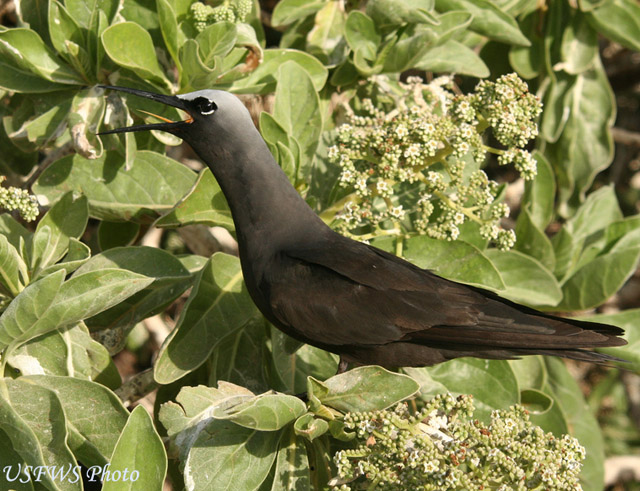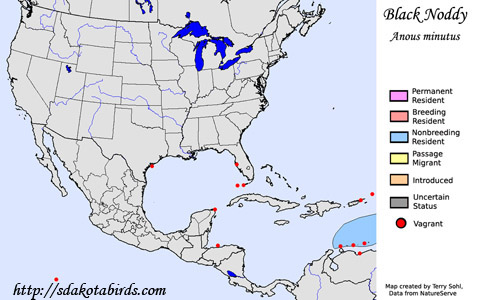| Length: 13.5 inches | Wingspan: 30 inches | Seasonality: Non-resident in South Dakota |
| ID Keys: Dark blackish plumage overall, whitish cap with gradual fade to grayish neck and black back, relatively long thin bill | ||
 The
Black Noddy is a close relative of the Brown
Noddy, a bird that nests at the Dry Tortugas off the Florida Keys.
However, the Black Noddy is but a rare vagrant in North America, with most
sightings consisting of single birds among the Brown Noddies at Dry
Tortugas. Elsewhere, they are found in tropical and subtropical areas,
with a widespread in the central and western Pacific, including around
Hawaii, eastern Australia and New Guinea. More scattered populations
occur off the west coast of Africa, southern Asia near India, the east coast
of South America, and the eastern Caribbean.
The
Black Noddy is a close relative of the Brown
Noddy, a bird that nests at the Dry Tortugas off the Florida Keys.
However, the Black Noddy is but a rare vagrant in North America, with most
sightings consisting of single birds among the Brown Noddies at Dry
Tortugas. Elsewhere, they are found in tropical and subtropical areas,
with a widespread in the central and western Pacific, including around
Hawaii, eastern Australia and New Guinea. More scattered populations
occur off the west coast of Africa, southern Asia near India, the east coast
of South America, and the eastern Caribbean.
Habitat: Found around islands in tropical and sub-tropical locations. Even outside of the breeding season, they are typically close to breeding islands or other islands on which they can roost at night.
Diet: Feeds on fish and small squid, as well as shrimp and krill.
Behavior: Forages by flying over the water's surface, dipping down to capture prey at or very near the surface.
Nesting: Colonial nesters, the nest of a Black Noddy is a large shallow cup built of grasses, leaves, sticks, seaweed, and moss, cemented together with excrement. It is usually placed in a small shrub or tree, in a rocky crevice, or on a cliff ledge. The female lays a single egg, and both parents help to incubate it. When the egg hatches, both parents help to feed the youngster. Fledging occurs after about 6 weeks, but the young Noddy is still fed by the parents for several weeks after fledging.
Interactive eBird Map: Click to access an interactive map of Black Noddy sightings
Song: Has a variety of calls, most with a harsh grunting or croaking tone.
Migration: Movements of Black Noddies depend upon location. Some birds are likely semi-permanent residents, with foraging and feeding outside of the breeding season still occurring close to breeding sites. In other areas, birds may disperse after breeding, although they typically are found close to islands where they can roost at night.
Similar Species: Similar in appearance to the Brown Noddy. The Black Noddy does have a darker blackish plumage overall, and is smaller with a noticeably longer and thinner bill.
Conservation Status: Populations are considered stable, they are found over a wide geographic area, and they are common in some parts of their range. The IUCN lists the Black Noddy as a species of "Least Concern".
Further Information: 1) Audubon Guide - Black Noddy
2) BirdLife International - Black Noddy
3) WhatBIrd - Black Noddy
Photo Information: Photo is public domain photo from U.S. Fish and Wildlife Service.
| Click below for a higher-resolution map |
 |
| South Dakota Status: Non-resident in South Dakota |
Additional Black Noddy Photos (coming soon!!)
